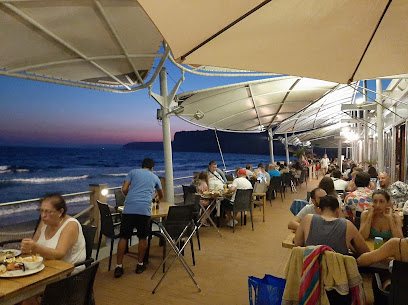
Kourion: The Ancient Marvel by the Sea
Explore the ancient ruins of Kourion in Cyprus, where history meets stunning Mediterranean views, offering a unique glimpse into the island's rich past.
The Kourion Archaeological Site in Cyprus is one of the island's most significant and fascinating historical attractions. Nestled on the southern coast, this ancient city offers breathtaking views of the Mediterranean Sea, making it a perfect blend of natural beauty and rich history. Visitors can explore the remnants of a once-thriving city that dates back to the 12th century BC. Among the highlights of Kourion are the well-preserved Greco-Roman theatre, which still hosts performances during the summer months, and the magnificent House of Eustolios, with its intricate mosaic floors. The site also features the early Christian basilica, public baths, and the Nymphaeum, showcasing the architectural and cultural grandeur of ancient Cyprus. Walking through Kourion, you will feel a sense of awe as you step back in time. The serene ambiance, coupled with the dramatic cliffside setting, provides a unique experience that is both educational and deeply moving. Whether you're a history enthusiast or simply seeking a picturesque spot, Kourion is sure to leave a lasting impression.
Local tips in Kourion Archaeological Site
- Visit early in the morning or late afternoon to avoid the midday heat and crowds.
- Wear comfortable walking shoes as the terrain can be uneven and rocky.
- Bring a hat, sunscreen, and plenty of water, as there is limited shade on the site.
- Check the schedule for performances at the ancient theatre for a unique cultural experience.
- Allocate at least two hours to explore the site thoroughly; there is a lot to see.
Kourion: The Ancient Marvel by the Sea
The Kourion Archaeological Site in Cyprus is one of the island's most significant and fascinating historical attractions. Nestled on the southern coast, this ancient city offers breathtaking views of the Mediterranean Sea, making it a perfect blend of natural beauty and rich history. Visitors can explore the remnants of a once-thriving city that dates back to the 12th century BC. Among the highlights of Kourion are the well-preserved Greco-Roman theatre, which still hosts performances during the summer months, and the magnificent House of Eustolios, with its intricate mosaic floors. The site also features the early Christian basilica, public baths, and the Nymphaeum, showcasing the architectural and cultural grandeur of ancient Cyprus. Walking through Kourion, you will feel a sense of awe as you step back in time. The serene ambiance, coupled with the dramatic cliffside setting, provides a unique experience that is both educational and deeply moving. Whether you're a history enthusiast or simply seeking a picturesque spot, Kourion is sure to leave a lasting impression.
When is the best time to go to Kourion Archaeological Site?
Iconic landmarks you can’t miss
Archaeological Site of the Tombs of the Kings
Uncover the ancient secrets of Cyprus at the Tombs of the Kings, a UNESCO World Heritage Site filled with historic significance and stunning architecture.

Κourion Ancient Amphitheater
Explore the Kourion Ancient Amphitheater, a stunning monument of ancient Greek architecture with breathtaking Mediterranean views, in the heart of Cyprus.
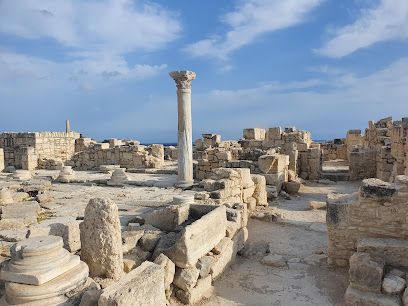
Archaeological Site of Palaepaphos
Explore the ancient wonders of Palaepaphos, a historical landmark filled with rich history, stunning mosaics, and breathtaking landscapes in Cyprus.
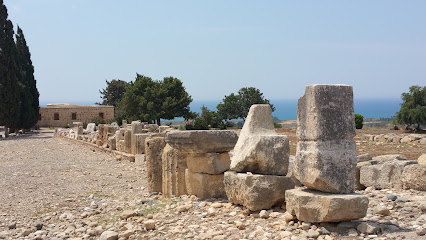
Nymphaeum of Kourion
Experience the rich history and breathtaking beauty of the Nymphaeum of Kourion, an ancient Roman landmark overlooking the Mediterranean in Cyprus.

Archaeological Site of Kition
Uncover the ancient history of Cyprus at the Archaeological Site of Kition, a stunning landmark filled with ruins and cultural significance near the Mediterranean coast.

Archaeological Site of Agios Georgios at Pegeia
Discover the enchanting Archaeological Site of Agios Georgios at Pegeia, where history and natural beauty converge along the stunning coast of Cyprus.
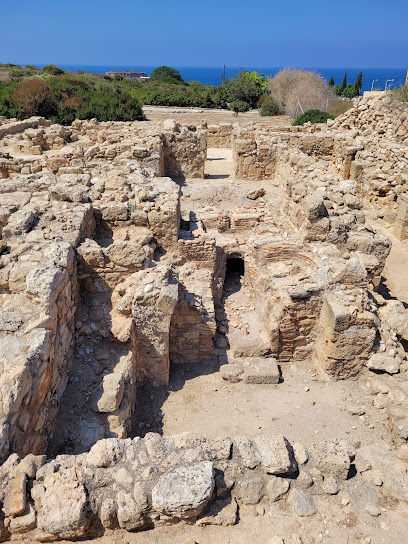
Archaeological Site of Tenta at Kalavasos
Explore the Archaeological Site of Tenta in Kalavasos, a remarkable journey into Cyprus's rich history with ancient ruins and stunning landscapes.
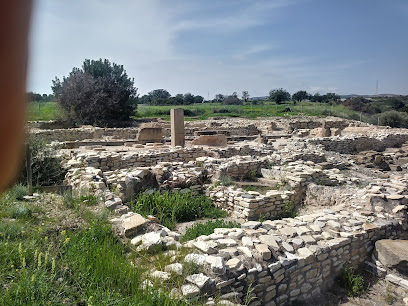
House of Eustolios
Explore the House of Eustolios in Episkopi, Cyprus, and immerse yourself in the exquisite beauty of ancient Roman mosaics and architecture.

Early Christian Basilica
Explore the Early Christian Basilica in Kourion, a stunning historical landmark showcasing beautiful mosaics and rich early Christian heritage.

Local Archaeological Museum of Kourion
Explore Cyprus' rich heritage at the Local Archaeological Museum of Kourion, showcasing ancient artifacts that tell the story of a bygone era.

Παλαιοχριστιανική Οικία με Τρικλίνιο
Explore the Triclinium at Kourion, a captivating historical site in Cyprus, showcasing exquisite Roman mosaics and breathtaking views of the Mediterranean coast.

House of the Gladiators
Explore the grandeur of Roman heritage at the House of the Gladiators, a captivating historical landmark in Episkopi, Cyprus.

Kourion archaelogical site
Explore Kourion Archaeological Site: Unveil the ancient wonders of Cyprus with stunning views, captivating ruins, and rich history.

House of Achilles
Explore the House of Achilles in Kourion, an archaeological marvel showcasing ancient Greek artistry and the epic tales of legendary heroes.

Saulrieta skata vieta
Experience the breathtaking beauty and rich history of Saulrieta Skata Vieta in the ancient ruins of Kourion, Cyprus.

Unmissable attractions to see
Υδροπάρκο Φασουρίου Watermania
Experience the ultimate water adventure at Fasouri Watermania, Cyprus's largest water park with thrilling slides and family-friendly fun.

Paphos Mosaics
Explore the breathtaking beauty of Paphos Mosaics, a UNESCO World Heritage site showcasing stunning ancient Roman artworks in Cyprus.
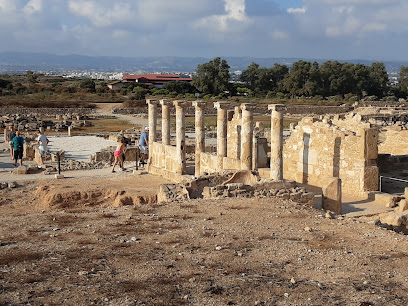
Archaeological Site of Amathous
Explore the rich history of the Archaeological Site of Amathous, a captivating blend of ancient ruins and stunning coastal views in Cyprus.

Archaeological Site of Palaepaphos
Explore the captivating Archaeological Site of Palaepaphos, a UNESCO World Heritage Site rich in history and mythology, in Kouklia, Cyprus.

Kourion Beach
Discover the enchanting Kourion Beach in Cyprus, where golden sands meet ancient history and breathtaking Mediterranean views.

Troodos Botanical Garden
Experience the beauty of nature at Troodos Botanical Garden, a serene escape in Cyprus showcasing diverse flora against stunning mountain backdrops.

Nymphaeum of Kourion
Discover the ancient wonder of the Nymphaeum of Kourion, a historical landmark showcasing exquisite mosaics and breathtaking views of the Mediterranean.

Platania
Explore the captivating landscapes and diverse wildlife of Platania National Reserve, a natural gem in Cyprus perfect for outdoor adventures and serene escapes.

Archaeological Site of Agios Georgios at Pegeia
Explore the Archaeological Site of Agios Georgios at Pegeia, where ancient history and stunning mosaics await your discovery.

Zapallo Bay, Episkopi, Cyprus
Experience the tranquility of Zapallo Bay in Episkopi, Cyprus, where stunning views and serene shores await every traveler.

Platres Chocolate Workshop
Discover the sweet art of chocolate making in the scenic village of Pano Platres, Cyprus, at the Platres Chocolate Workshop.

Archaeological Museum of the Lemesos (Limassol) District
Explore the Archaeological Museum of the Lemesos District in Limassol, a captivating journey through Cyprus's rich historical heritage with fascinating artifacts.

Agios Ermogenis
Explore Agios Ermogenis, a hidden church gem in Episkopi, Cyprus, rich in history and serene beauty, perfect for a peaceful retreat.
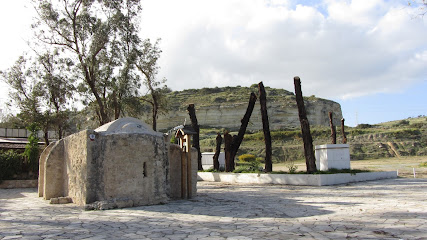
Bee & Embroidery Museum
Discover the artistry of Cypriot embroidery and the fascinating world of beekeeping at the Bee & Embroidery Museum in Kato Drys.
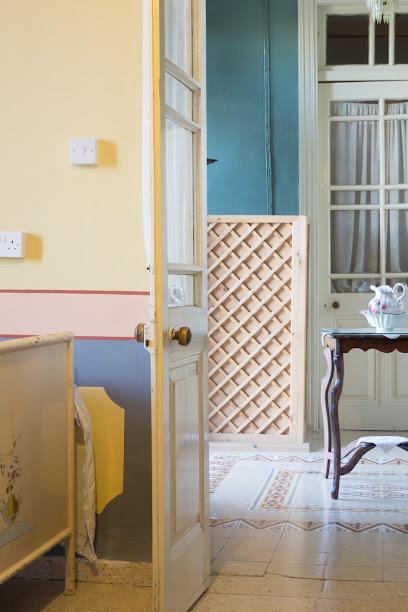
Zambartas Wineries
Explore the exquisite flavors of Cyprus at Zambartas Wineries, where tradition meets modern winemaking in a stunning vineyard setting.

Markets, malls and hidden boutiques
Nymphaeum of Kourion
Explore the Nymphaeum of Kourion, a breathtaking historical landmark in Cyprus featuring ancient ruins and stunning Mediterranean views.

Early Christian Basilica
Explore the Early Christian Basilica at Kourion, a stunning historical landmark showcasing exquisite mosaics and rich early Christian architecture.

Local Archaeological Museum of Kourion
Discover the ancient wonders of Cyprus at the Local Archaeological Museum of Kourion, a cultural gem showcasing remarkable artifacts and rich history.

Kourion archaelogical site
Explore the Kourion archaeological site and step back into ancient history while enjoying stunning coastal views.
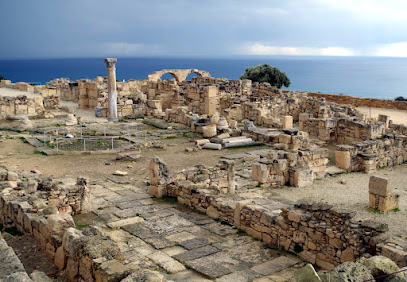
Essential bars & hidden hideouts
Chris Blue Beach
Experience the perfect blend of fresh seafood and stunning beach views at Chris Blue Beach in Cyprus, a culinary gem along the Mediterranean coast.
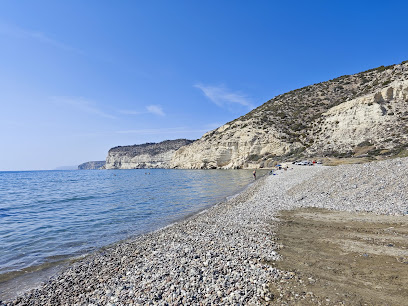
Kourion Beach Restaurant
Discover Kourion Beach Restaurant, where stunning views meet delicious local cuisine in the heart of Cyprus's coastal paradise.

ST.Ermogenis Tavern
Savor the flavors of Cyprus at ST. Ermogenis Tavern, where authentic dishes meet warm hospitality in the heart of Episkopi.

Local Phrases about Kourion Archaeological Site
-
- HelloΓεια σας
[Yia sas] - GoodbyeΑντίο
[Adio] - YesΝαι
[Ne] - NoΌχι
[Ohi] - Please/You're welcomeΠαρακαλώ
[Parakalo] - Thank youΕυχαριστώ
[Efharisto] - Excuse me/SorryΣυγγνώμη
[Signomi] - How are you?Τι κάνετε;
[Ti kanete?] - Fine. And you?Καλά. Εσείς;
[Kala. Esis?] - Do you speak English?Μιλάτε Αγγλικά;
[Milate Agglika?] - I don't understandΔεν καταλαβαίνω
[Den katalaveno]
- HelloΓεια σας
-
- I'd like to see the menu, pleaseΘα ήθελα να δω το μενού, παρακαλώ
[Tha ithela na do to menou, parakalo] - I don't eat meatΔεν τρώω κρέας
[Den troo kreas] - Cheers!Στην υγειά μας!
[Stin igia mas] - I would like to pay, pleaseΘα ήθελα να πληρώσω, παρακαλώ
[Tha ithela na plirosso, parakalo]
- I'd like to see the menu, pleaseΘα ήθελα να δω το μενού, παρακαλώ
-
- Help!Βοήθεια!
[Voithia!] - Go away!Πήγαινε μακριά!
[Pigaine makria!] - Call the Police!Καλέστε την Αστυνομία!
[Kaleste tin Astynomia!] - Call a doctor!Καλέστε γιατρό!
[Kaleste giatro!] - I'm lostΈχω χαθεί
[Eho hathi] - I'm illΕίμαι άρρωστος
[Ime arrostos]
- Help!Βοήθεια!
-
- I'd like to buy...Θα ήθελα να αγοράσω...
[Tha ithela na agoraso...] - I'm just lookingΑπλά κοιτάω
[Apla kito] - How much is it?Πόσο κοστίζει;
[Poso kostizi?] - That's too expensiveΑυτό είναι πολύ ακριβό
[Afto ine poli akribo] - Can you lower the price?Μπορείτε να μειώσετε την τιμή;
[Borite na meiosete tin time?]
- I'd like to buy...Θα ήθελα να αγοράσω...
-
- What time is it?Τι ώρα είναι;
[Ti ora ine?] - It's one o'clockΕίναι μία ώρα
[Ine mia ora] - Half past (10)Μισή (10)
[Misi (10)] - MorningΠρωί
[Proi] - AfternoonΑπόγευμα
[Apoyevma] - EveningΒράδυ
[Vradi] - YesterdayΧθες
[Hthes] - TodayΣήμερα
[Simera] - TomorrowΑύριο
[Avrio] - 1Ένα
[Ena] - 2Δύο
[Dio] - 3Τρία
[Tria] - 4Τέσσερα
[Tessera] - 5Πέντε
[Pente] - 6Έξι
[Exi] - 7Εφτά
[Efta] - 8Οχτώ
[Ohto] - 9Εννιά
[Ennia] - 10Δέκα
[Deka]
- What time is it?Τι ώρα είναι;
-
- Where's a/the...?Πού είναι ένα/το...;
[Pou ine ena/to...?] - What's the address?Ποια είναι η διεύθυνση;
[Pia ine i diefthinsi?] - Can you show me (on the map)?Μπορείτε να μου δείξετε (στο χάρτη);
[Borite na mou dixete (sto charti)?] - When's the next (bus)?Πότε είναι το επόμενο (λεωφορείο);
[Pote ine to epomeno (leoforeio)?] - A ticket (to ....)Ένα εισιτήριο (για ....)
[Ena isitirio (ya ....)]
- Where's a/the...?Πού είναι ένα/το...;
History of Kourion Archaeological Site
-
Kourion was founded in the 12th century BCE by the Mycenaeans, who were drawn to the strategic location and fertile land. The city prospered as a major trading center due to its advantageous position along the coast of Cyprus.
-
During the Hellenistic period, following the conquests of Alexander the Great, Kourion saw significant growth and development. The city was influenced by Greek culture, evidenced by the construction of notable structures such as the Sanctuary of Apollo Hylates.
-
In 58 BCE, Cyprus became a part of the Roman Empire. Kourion flourished under Roman rule, becoming an important administrative and economic center. The city was adorned with grand buildings, including a theater, public baths, and elaborate villas with intricate mosaics.
-
On July 21, 365 CE, a massive earthquake struck the Mediterranean region, causing significant damage to Kourion. Many buildings were destroyed, and the city's infrastructure suffered greatly. The earthquake marked a turning point in Kourion's history, leading to a period of decline.
-
Despite the devastation caused by the earthquake, Kourion remained inhabited during the Byzantine period. The city saw the construction of several Christian basilicas, indicating the spread of Christianity in the region. The House of Eustolios, a complex with impressive mosaics, dates back to this era.
-
In the 7th century CE, Kourion faced raids from Arab forces. These incursions further contributed to the city's decline, leading to the eventual abandonment of Kourion by the late medieval period. The archaeological remains of the city were gradually buried over time, only to be rediscovered in the modern era.
-
The archaeological significance of Kourion was recognized in the early 20th century, leading to extensive excavations. Archaeologists unearthed a wealth of artifacts and structures, shedding light on the city's rich history and cultural heritage.
Kourion Archaeological Site Essentials
-
Kourion Archaeological Site is located on the southwest coast of Cyprus, near the city of Limassol. The nearest international airport is Larnaca International Airport, which is about 70 kilometers away. From the airport, you can rent a car, take a taxi, or use a shuttle service to get to Limassol. From Limassol, Kourion is just a short drive away, approximately 15 kilometers to the west. Public buses also operate from Limassol to Kourion, providing a budget-friendly option.
-
Once you arrive in Limassol, getting to Kourion is relatively easy. Renting a car is the most convenient option, allowing you to explore the area at your own pace. Taxis are also available and can be booked in advance. Public buses run regularly from Limassol to Kourion, with stops near major hotels and tourist areas. If you prefer guided tours, several companies offer organized trips to Kourion, often including other nearby attractions.
-
The official currency in Cyprus is the Euro (EUR). Credit and debit cards are widely accepted in most places, including at the Kourion Archaeological Site's ticket office and nearby cafes. However, it is advisable to carry some cash for smaller establishments or in case of technical issues with card payments. ATMs are available in Limassol and other nearby towns, so you can easily withdraw cash if needed.
-
Kourion Archaeological Site and the surrounding areas are generally safe for tourists. However, as with any travel destination, it is important to remain vigilant. Petty theft can occur, especially in crowded areas, so keep an eye on your belongings. Avoid isolated areas after dark and stick to well-lit, populated places. Limassol, being a larger city, has some neighborhoods where crime rates are higher, but these areas are not typically near tourist attractions.
-
In case of an emergency, dial 112 for immediate assistance. This number will connect you to police, fire, and medical services. The nearest hospital to Kourion is in Limassol, which has modern medical facilities. It is advisable to have travel insurance that covers medical emergencies. For minor health issues, there are pharmacies in Limassol where you can purchase over-the-counter medications.
-
Fashion: Do wear comfortable clothing and sturdy shoes, as the terrain can be uneven. Avoid wearing high heels or flip-flops. Religion: Do respect the ancient ruins and any religious artifacts. Refrain from loud behavior and dress modestly. Public Transport: Do be courteous to bus drivers and fellow passengers. Don’t eat or drink on public transport. Greetings: Do greet people with a friendly 'hello' or 'kalispera' (good evening in Greek). A handshake is also appropriate. Eating & Drinking: Do try the local cuisine and drink plenty of water, especially in the summer. Don’t leave litter behind at the site.
-
To experience Kourion like a local, visit early in the morning or late in the afternoon to avoid the heat and crowds. Bring a hat, sunscreen, and plenty of water. Engage with local guides who can provide fascinating insights into the history and significance of the site. Don’t miss the ancient theater, which still hosts performances during the summer months. Nearby, the beach at Kourion is a great spot for a swim after your visit.
Trending Landmarks in Kourion Archaeological Site
-
Archaeological Site of the Tombs of the Kings
-
Κourion Ancient Amphitheater
-
Archaeological Site of Palaepaphos
-
Nymphaeum of Kourion
-
Archaeological Site of Kition
-
Archaeological Site of Agios Georgios at Pegeia
-
Archaeological Site of Tenta at Kalavasos
-
House of Eustolios
-
Early Christian Basilica
-
Local Archaeological Museum of Kourion
-
Παλαιοχριστιανική Οικία με Τρικλίνιο
-
House of the Gladiators
-
Kourion archaelogical site
-
House of Achilles
-
Saulrieta skata vieta
Nearby Cities to Kourion Archaeological Site
-
Things To Do in Pissouri
-
Things To Do in Troodos
-
Things To Do in Paphos
-
Things To Do in Kato Paphos
-
Things To Do in Polis Chrysochous
-
Things To Do in Larnaca
-
Things To Do in Nicosia
-
Things To Do in Kyrenia
-
Things To Do in Ayia Napa
-
Things To Do in Famagusta
-
Things To Do in Protaras
-
Things To Do in Alanya
-
Things To Do in Beirut
-
Things To Do in Batroun
-
Things To Do in Sidon









